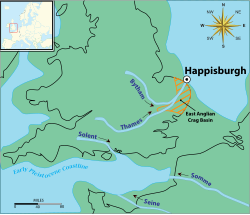
The Happisburgh footprints were a set of fossilized hominid footprints that date to the end of the Early Pleistocene, around 950–850,000 years ago. They were discovered in May 2013 in a newly uncovered sediment layer of the Cromer Forest Bed on a beach at Happisburgh in Norfolk, England, and carefully photographed in 3D before being destroyed by the tide shortly afterwards.
Research results on the footprints were announced on 7 February 2014, identifying them as the oldest known hominid footprints outside Africa.[1][2][3]
Before the Happisburgh discovery, the oldest known footprints in Europe were the Ciampate del Diavolo tracks found at the Roccamonfina volcano in Italy, dated to around 350,000 years ago.[4]
Winning the 2015 'Rescue Dig of the Year' award, the Happisburgh footprint discovery caught the public eye. It was featured in an exhibition in London's Natural History Museum.
- ^ Ghosh, Pallab (7 February 2014). "Earliest footprints outside Africa discovered in Norfolk". BBC News. Archived from the original on 19 June 2018. Retrieved 7 February 2014.
- ^ Ashton N, Lewis SG, De Groote I, Duffy SM, Bates M, et al. (2014)"Hominin Footprints from Early Pleistocene Deposits at Happisburgh, UK" Archived 22 August 2014 at the Wayback Machine, PLoS ONE 9(2): e88329. doi:10.1371/journal.pone.0088329
- ^ Ashton, Nicholas (7 February 2014). "The earliest human footprints outside Africa". British Museum. Archived from the original on 7 February 2014. Retrieved 7 February 2014.
- ^ Bennett, Matthew R.; Morse, Sarita A. (2014). Human Footprints: Fossilised Locomotion?. Springer. p. 59. ISBN 978-3-319-08572-2.